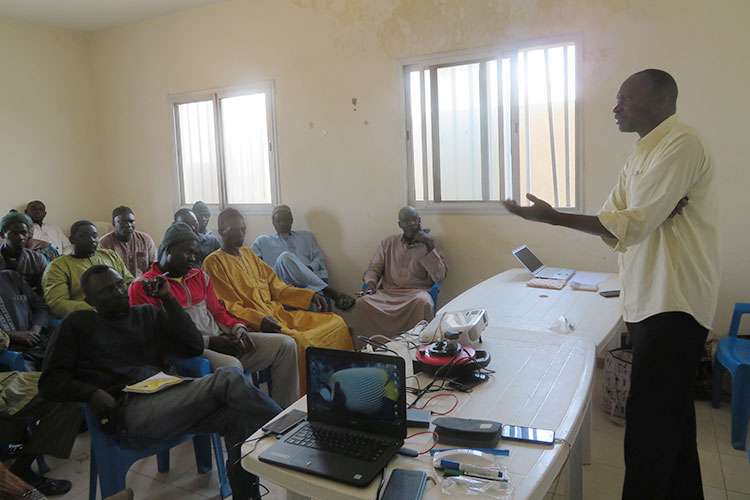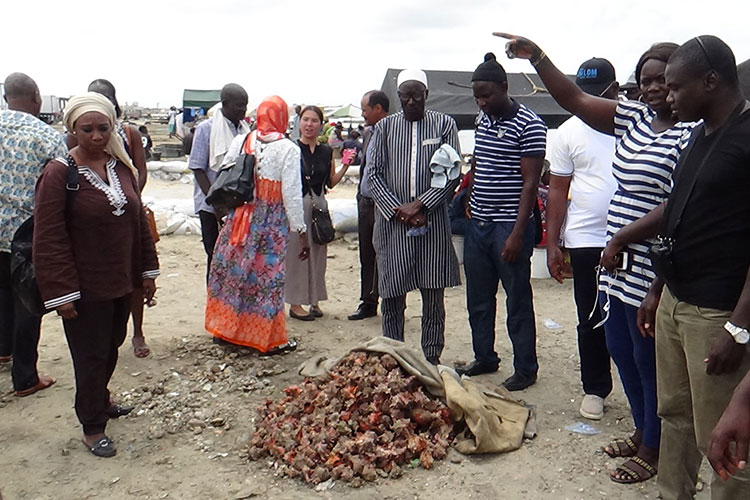2.2 Training of stakeholder leaders from fishing villages
Regardless of the existence of an organisation responsible for the co-management of fisheries resources, it is normal for multiple members in the organisation to have their own interests, positions, and ideas. The major role of stakeholder leadership in promoting resource management is to create a common goal of resource management among members with various ideas and positions.
In co-management, fishery leaders must make sound judgements and have technical skills acceptable to members of each occupational group; understand the status of target fisheries resources and the implications of fishing regulations, such as no-fishing seasons and catch size limits; coordinate opinions within and between groups; and build consensus among stakeholders. Leaders in resource management activities can acquire these skills through practical field activities and leadership training.
The steps include assigning leaders, determining their roles, and building their capacity.
- Assign leaders and determine their roles
- Build the capacity of leaders through training
- Enhance leaders’ capacities through practice
- Strengthen the capacity of leaders as an information hub
Assign leaders and determine their roles.
The ideas of each identified group and the relationships among groups should be clarified through activities, such as workshops in fishing villages and the formation of resource management organisations. Then, a leader is assigned to each group (self-recommendation or recommendation by others) and their roles will be determined through participatory methods during community meetings in fishing villages or regular meetings of resource management organisations.
Build the capacity of leaders through training.
The capacities required for each role of the assigned leaders should be listed and training to build these capacities should be planned. A visit to an advanced fishery co-management site near the target area would be helpful in planning such training. The purpose and outline of the training is explained to all leaders in attendance and information is provided to help them understand the training and enhance their participation.
The schedule and budget for various training sessions are prepared and approved by the organisation. In general, participating leaders must strengthen the following knowledge and capacities.
- a. Knowledge of resource management measures and their effects
- b. The current state of resource management in the surrounding areas and other countries by visiting advanced areas of resource management
- c. The ability to plan and implement fisheries resource management
- d. Improving the ability to coordinate opinions among groups and build consensus among stakeholders


Enhance leaders’ capacities through practice.
Each leader provides a daily opportunity or platform for discussions within their group to understand the positions, ideas, and opinions of each member. Leaders also actively participate in the meetings of other groups to deepen their understanding of each group’s position and challenges. Group meetings and fishing village meetings will be held regularly to inform participants of the status and challenges of resource management activities, discuss them, and review activities if necessary. The leader also shares with the group members the training information provided by the Fisheries Directorate and donors and actively encourages the group members to participate in the training. The leader should determine what kinds of activities and training the group members want.
Awareness-raising activities can be an effective means for leaders to strengthen their capacities through practice. Organisations that promote resource management activities, such as the Directorate of Fisheries, local authorities, and donors, have created tools such as posters and educational materials using videos and photographs in cooperation with local resource management organisations. Fishermen leaders will use these tools to raise awareness among fishery stakeholders. These measures can be combined with radio broadcasts and other awareness-raising activities aimed at consumers to encourage them not to buy protected immature resources and illegal catches in the market.
8. Creating tools for awareness-raising activities 1
To raise awareness of resource management activities, the JICA COGEPAS project created and used panels and posters at landing sites and case videos of practical examples.
9. Creating tools for awareness raising 2
In Senegal, various resource management activities have been conducted at the initiative of local communities. However, how many people in the communities have been involved in these efforts? Have the activities remained with a limited number of people? What kind of educational activities are needed to promote wider participation of the communities?
To address such issues, COPAO, a JICA project, conducted a campaign to release juvenile cymbium, and created a character logo that community members would be familiar with. An animation featuring the character was created based on the scene of the release of collected juvenile cymbium shells.
Fishermen, local elementary and junior high school students, and others involved in the fishery industry participated in the recording of the animation, and many community members watched it and became familiar with the character. Various printed materials and T-shirts with the character's logo were distributed, and the animation was shown as a tool to raise awareness of the activities for releasing young clams.

10. Awareness-raising activities undertaken by fishermen leaders on their own
When fishers’ leaders take the initiative to conduct activities, they automatically develop leadership qualities. Such an activity in itself raises awareness. Awareness-raising activities that fisherfolk leaders engage in voluntarily include door-to-door visits, visiting fishers’ rest areas on the beach, group meetings, exchange between villages, calls in a public space, making panels for landing sites, and local radio broadcasts. According to the experience of the JICA COGEPAS project, the most effective awareness-raising activities at the planning stage of resource management activities were door-to-door visits, visiting fishers’ rest areas on the beach, group meetings, and exchange between villages, while the most effective activities at the implementation stage of resource management activities were group meetings, calls in a public space, making panels for landing sites, and local radio broadcasts.


Strengthen the capacity of leaders as an information hub.
A platform for the leaders who participated in the training should be kept continuously to exchange information on their individual activities, share the current situation, and exchange views after training. In this way, leaders from different countries can be linked so as to share their experiences in diverse situations. This information can be further shared with other members of the group through the leaders.
Moreover, leaders should meet regularly with officials from the Fisheries Service, local governments, and donor agencies to discuss the needs of each group and the technical training needed. The Directorate of Fisheries, local authorities, and donors should endeavour to organise and deliver training in the improvement of fishing gear and the introduction of new technologies for the management of fisheries resources. If necessary, leaders should consider planning and conducting training for distributors and processors to introduce them to freshness, sanitation, and processing techniques to improve their incomes. This information will be shared among leaders at regular meetings, which in turn will be shared with group members.
In this way, the leader of each organisation can gain the trust of its members and strengthen their own leadership capacity by acting as a hub that connects group members to external organisations and various external sources of information.
11. Capacity building for leaders as an information hub
The JICA project COPAO was implemented in Senegal and seven neighbouring countries. In each of the neighbouring countries, a focal person was appointed and participated in COPAO activities. He or she and their colleagues deepened their understanding of Senegal's co-management practices through participating in the regional training conducted in the country. They also deepened their understanding of the situation in not only Senegal but also the neighbouring countries by sharing with each other the current situation, challenges, and practical examples of co-management in the neighbouring countries. They also exchanged views with representatives of the CSRP, which aims to harmonize resource management policies in western Africa. It should be noted that fishermen's representatives from the neighbouring countries also participated in these activities.
The COPAO focal persons and fishermen's representatives who participated in these activities served as an information hub for the relevant countries and organizations after their return to their home country, thereby enhancing their ability as leaders to propose better solutions and promote consensus building for joint resource management.

